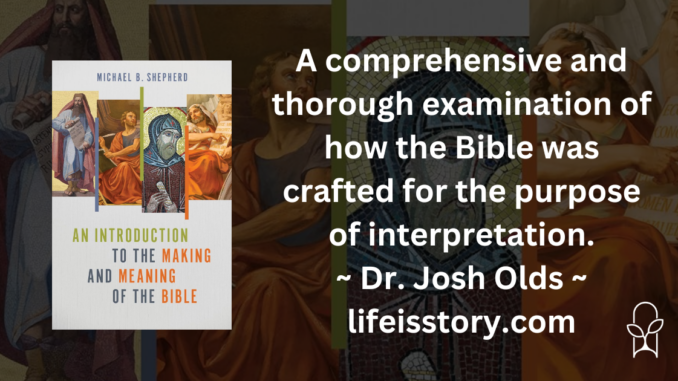
Published by Eerdmans on April 2, 2024
Genres: Academic, Non-Fiction, Theology
Buy on Amazon
Goodreads

A comprehensive and orthodox guide to biblical origins and interpretation
How did we get the Bible? How do we interpret it? And what does it mean for our lives today? Michael B. Shepherd introduces undergraduates and seminarians to these crucial questions in this reliable and thorough new textbook.
Shepherd covers textual criticism, formation of the canon, and history of translation, all while remaining committed to Scripture’s ultimate purpose—inviting us to salvation through Jesus Christ. Showing how the Bible directs its own interpretation, Shepherd encourages learners to listen to the Word of God, rather than twisting it to fit their own ends. His section-by-section treatment of the Bible encourages students to view the Bible as cohesive, while remaining sensitive to its diverse genres.
Thorough and accessible, this textbook goes beyond typical historical introductions to spiritually form students learning to understand Scripture. An Introduction to the Making and Meaning of the Bible is the serious, evangelical introduction your students need and will reference for years to come.
It’s the best-selling book of all time. Go to virtually any bookstore and they’re bound to have a copy somewhere. Millions are printed every year in various bindings, in various translations, with various study guides embedded. But how did we actually get the Bible?
An Introduction to the Making and the Meaning of the Bible offers readers a comprehensive and thorough examination of that question, focusing in particular on how the making has affected the meaning. The book is written by Dr. Michael Shepherd, professor of biblical studies at Cedarville University, and is structured like a seminary course in a book. Don’t let the term “introduction” fool you. This is an academic book. It is introductory in the sense that it is a beginning overview of an academic study of the Bible’s translation, transmission, and textual criticism, not that it is for beginners. The back cover copy says clearly that the intended audience is for “undergraduates and seminarians” and that this is to be a “reliable and thorough new textbook.”
The first chapter of the book covers the making of the Bible. Shepherd covers the different types of literary genre that comprise Scripture and gives an overview of each. He talks about how each of these genres help us interpret the meaning of the text and provide literary clues for exegesis. This focus on the meaning is paramount throughout the book. Shepherd’s thesis is that Scripture is self-interpreting, that is to say, they were written with a meaning and message in mind and so the composition of the work bears that out.
The second chapter deals with text, transmission, and translation. Shepherd discusses early translations of the Hebrew Bible, in particular noting the influence of the Septuagint Greek translation of the Hebrew Bible to the New Testament writings. He details the different translational traditions and shows how all of these variant traditions have been combined into a critical text. He then does the same for the New Testament before moving on to a discussion of English translations of the Bible.
The next two chapters are the meat of An Introduction to the Making and the Meaning of the Bible, showing how the composition (the making) of Scripture affects its exegesis (the meaning). Shepherd shows that the way in which the Bible was written holds the key to its interpretation. There’s so much to dive into here that each chapter could be a volume in its own right, but this is an introduction and Shepherd offers just a cursory skip over the material, offering enough insight to point the reader in the right direction to more in-depth research.
I’ve read any number of books that interpret Scripture. I’ve read any number of books that give an overview of how we got the Bible. I don’t know that I’ve read anything that ever combined the two to show how making affects the meaning. Just by introducing that concept, An Introduction to the Making and the Meaning of the Bible is an important addition to the literature. The stories that are told, the way they are told, and how they are told all have meaning that then informs our interpretation and our practical application. The nuts and bolts of how the Bible came to be can often be thought of as a dry, academic exercise but Shepherd shows that the making matters—and when we understand how we got the Bible we put ourselves in a better position to be able to live out its precepts.
